Last weekend at the Woodlands Resort in North Pattaya the Rotary Club of Jomtien-Pattaya held a Fellowship Party to assist the proposed A.X. Fassbind Foundation. This was so successful that the financial assistance offered will be enough to ensure that the new Foundation will become reality. A reality that will benefit Pattaya, its people and its image.
Following the untimely death of Louis Fassbind late last year, it became apparent to many people that Pattaya had lost its icon. "Mr. Pattaya" was the title he had been given by the world, a world that knew him, or of him, and his promotion of this city.
It was also obvious that Pattaya was in danger of losing the momentum that
Fassbind had generated in striving for excellence in the Tourism and Hospitality field. It
was then that it was decided that his good work for Pattaya over such a long period needed
more than just a statue in a park. It needed a Foundation to carry on the work of Louis
Fassbind, work that would benefit all of Pattaya’s people.
To institute a Foundation requires more than just a committee of willing souls. It needs to have a sound financial basis as well. After Louis’ passing, many of his friends donated money towards continuing his work and it would have been easy to just spend and fritter these donations away. This lack of direction was not the Fassbind style, and with the backing of a small committee chaired by Sutham Phanthusak it was decided to go the whole way and continue the work. That decision meant that many people would have to become involved to get the Foundation up and running.
The Rotary club of Jomtien-Pattaya , of which Louis Fassbind was a foundation member, then got behind the concept and it was suggested that the proceeds from a Fellowship party could be directed towards the fledgling Foundation. All that was needed next was a venue - and Khun Sutham immediately suggested that his facility at Woodlands Resort could be used. From there, the Royal Cliff Beach Resort and the Dusit Resort donated equipment and it began to become a reality. Pattaya groups, organizations and businesses all pulled together for a collective good.
It was not long before tickets were printed, Pattaya Mail was advertising and Pattaya began to talk about the forthcoming party. Louis Fassbind was generating enthusiasm yet again!
 The party venue at the Woodlands Resort was packed
with over 350 tickets pre-sold for the evening. Khun Ning, Louis Fassbind’s personal
secretary selling over 80 tickets herself. Seated at tables all over the grounds were
friends of Fassbind or just people who believe in the future for Pattaya. From public
office holders like Khun Prasert Thanasethakorn, the Chief of Banglamung District and
Mayor Pairat Suthithamrongsawat, the attendees swelled encompassing so many of
Pattaya’s principal people. Rotary luminaries included Past District Governors Nelson
Alexander and Xanxai Visitkul along with one of the principal sponsors of the evening
Jan-Olaf Aamlid, the Norwegian numismatist, co-sponsor Peter Thorand and current President
John Richards, as well as many Past Presidents and Rotarians from other clubs in Thailand.
The party venue at the Woodlands Resort was packed
with over 350 tickets pre-sold for the evening. Khun Ning, Louis Fassbind’s personal
secretary selling over 80 tickets herself. Seated at tables all over the grounds were
friends of Fassbind or just people who believe in the future for Pattaya. From public
office holders like Khun Prasert Thanasethakorn, the Chief of Banglamung District and
Mayor Pairat Suthithamrongsawat, the attendees swelled encompassing so many of
Pattaya’s principal people. Rotary luminaries included Past District Governors Nelson
Alexander and Xanxai Visitkul along with one of the principal sponsors of the evening
Jan-Olaf Aamlid, the Norwegian numismatist, co-sponsor Peter Thorand and current President
John Richards, as well as many Past Presidents and Rotarians from other clubs in Thailand.
The Tourism and Hospitality guru’s came in force, from the well established such as Bruno Forrer, Walter Tensich and Michael Vogt, to the newcomers as Jean-Fernand Wasser and Murray Hertz. Local business people were also there in force with Khun Supadit Maneeratjaratsri and the Bonds present in person, while Khun Sutham Phanthusak rang from the International Scout Jamboree in Chile to ensure everything was going well.
On stage, the entertainment for the evening was the KwaZulu-Natal Youth Wind Band. A classy 45 member musical group that would have been the type of promotion Louis himself would have chosen .
Master of Ceremonies was Peter Malhotra, representing not just the Pattaya Mail, but also the many, many friends of Louis Fassbind. His eulogy to the memory of Louis caused the hundreds of people present to stand and drink a toast, not just to Fassbind’s memory, but to the future.
In typical Pattaya fashion (and with great flair) two of the "ladies" from the Tiffany Show moved around the tables selling tickets. Raffles and lucky door prizes were drawn and the principal prize of a Business Class return ticket to Singapore on SAS went to the excited Nualnoi Pooapilak, an assistant accountant at the Royal Cliff Beach Resort. The organisers thanked everyone who had helped make the event such a success, and everyone enjoyed another great Fassbind party.
The support shown to the Foundation will allow its formal establishment and allow it to pursue its Objectives of:
1. To commemorate the life, dedication and achievements of A.X. Fassbind
to the Tourism and Hospitality industry in Thailand.
2. To promote the highest standards possible in the Tourism and Hospitality industry in
Thailand.
3. To promote and sponsor educational scholarships in the Tourism and Hospitality industry
in Thailand.
4. Continue to maintain the Fassbind Medical Home at the Banglamung Home for the Aged.
Amongst those who donated that evening were Erwin Rohner who presented the Foundation with 15,000 Baht, Jomtien-Pattaya Rotary Club (30,000 Baht) and the Rotary Club of Bangkok South (5,000 Baht). These donations are being added to the others that came in spontaneously after Fassbind’s death. The Foundation, in his name, will be able to assist Pattaya to become the prime resort it can be.
Louis Fassbind had a grand plan for Pattaya and that has not died with him. It will continue. Watch this space!
| The
KwaZulu-Natal Youth Wind Band
Pattaya was very fortunate to secure the South
African youngsters to perform at both the Royal Cliff Beach Resort and at the A.X.
Fassbind Fellowship party last weekend.
An extremely well disciplined symphonic wind band (woodwinds, brass and
percussion), it has already achieved that aim, having won two international Gold Medals in
the past two years, with the latest being in Bangkok this month playing against ten other
talented international standard outfits. The young musicians, 45 of them on this tour ranging in age between 13 and 23 years old, play a variety of instruments, including Flute, Piccolo, Oboe, Bassoon, Saxophone, Clarinet, Trumpet, Trombone, Euphonium, Tuba and a collection of percussion instruments. Their repertoire is extensive covering Strauss to Sousa as well as Anka to Andrew Lloyd Webber with a collection of Glen Miller favourites in between. The province of KwaZulu-Natal has certainly scored a musical hit using this band as international representatives for South Africa. |
 The conductor,
Werner Dannewitz, himself a professional clarinetist, has been involved with this band
(and its fore-runner) for the past twenty years. His goal, for the band, is to
"...strive for musical excellence" and undoubtedly he has managed to accomplish
this.
The conductor,
Werner Dannewitz, himself a professional clarinetist, has been involved with this band
(and its fore-runner) for the past twenty years. His goal, for the band, is to
"...strive for musical excellence" and undoubtedly he has managed to accomplish
this.
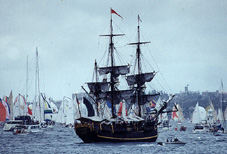 The fleet races
out of Sydney’s calm, past a replica of the “Endeavour” to sail into the
ferocity of a Bass Straight gale. Photo Peter Cummins.
The fleet races
out of Sydney’s calm, past a replica of the “Endeavour” to sail into the
ferocity of a Bass Straight gale. Photo Peter Cummins.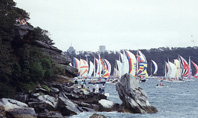 115 yachts set
out: less than half finished as the “southerly bluster” took its toll on man and
machine. Photo Peter Cummins.
115 yachts set
out: less than half finished as the “southerly bluster” took its toll on man and
machine. Photo Peter Cummins.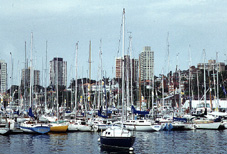 The
Sydney-Hobart fleet etched against the Sydney city-scape: unaware of the terror ahead.
Photo Peter Cummins.
The
Sydney-Hobart fleet etched against the Sydney city-scape: unaware of the terror ahead.
Photo Peter Cummins.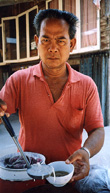 Uncle Duan
serves up the “house” specialty.
Uncle Duan
serves up the “house” specialty.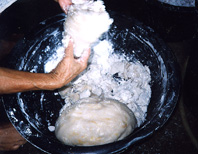 Auntie Boonchuay
kneads the khanom to make it just right.
Auntie Boonchuay
kneads the khanom to make it just right.